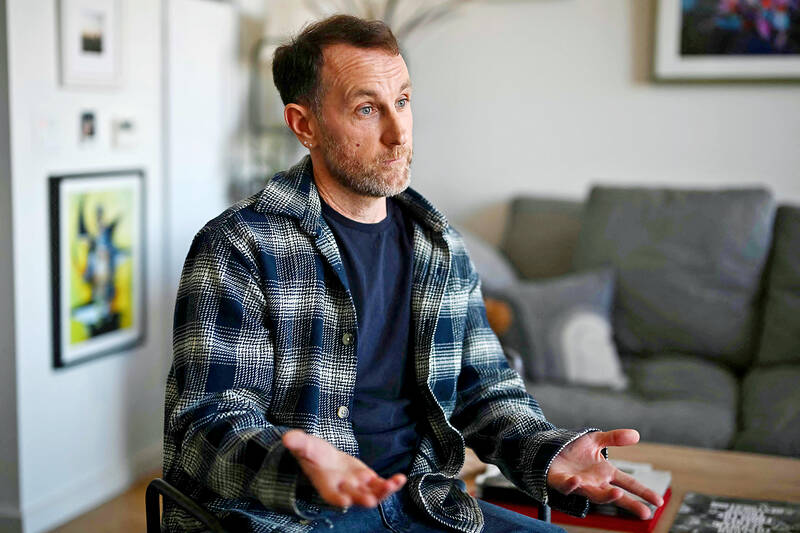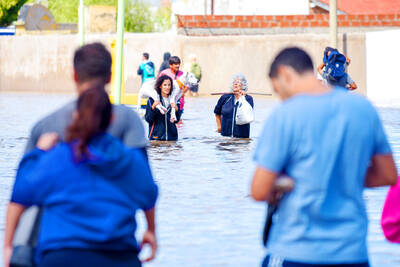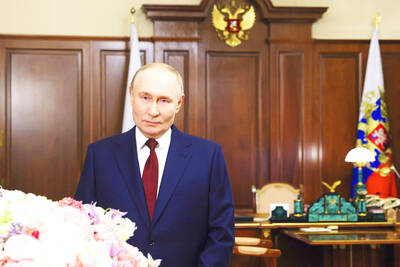Joseph Lynskey was quietly waiting for the New York subway on New Year’s Eve when someone shoved him from behind onto the tracks as a train pulled into the station.
Highly publicized horror stories such as Lynskey’s have had a chilling effect on many New Yorkers even as authorities say crime is down on the metro system and across the city.
Lynskey survived because he fell into a deep, recessed space under the train and between the tracks, and was not hit by the wheels, but rather the undercarriage.

Photo: AFP
“I knew instantly ... that somebody had pushed me and tried to kill me,” the music producer said of the attack at 18th Street subway station in the Chelsea neighborhood of Manhattan. “When I hit the tracks and I opened my eyes, the train was on top of me. It was so fast.”
He recalled thinking: “I’m going to get hit by the train and I’m going to die.”
A 45-year-old adopted New Yorker, he has not been able to return to the subway, used by 4 million people daily who flock to the sprawling network of 472 stations and more than 950km of track, running day and night.
When he looked around after falling onto the tracks, Lynskey recalled being just centimeters from the high-voltage rail that powers trains, and seeing his blood pooling on the rail bed.
He was left with a fractured skull, four broken ribs and a ruptured spleen.
“I knew that I had to remain calm. There was nobody on the platform answering my calls for help. For about 90 seconds, I was alone, screaming for help,” he said. “A woman started answering me ... a Good Samaritan. She asked me what my name was. She asked me if I could move. She asked me if I could wiggle my fingers and wiggle my toes to see if, I guess, if I was paralyzed, and I think she was trying to keep me awake.”
Within minutes firefighters, police and subway workers arrived, with two firefighters retrieving him from the tracks, having been trained to do so just days before.
Lynskey later met his rescuers to give them a hug and thank them properly.
His rescue was captured on film and widely shared on social media, with rescuers expressing surprise that he was alive once he was lifted through the gap between two carriages.
Lynskey still struggles to understand why his attacker, a 23-year-old man with criminal convictions and mental health issues, would want to harm him.
He chooses instead to focus his attention on the kindness of strangers, like those who have written to him from around the world to express solidarity.
Last year, 26 people were pushed or fell onto tracks, one of whom died, an increase of nine on 2023, police said.
Cases such as Lynskey’s, although rare, attract a disproportionate share of headlines and public awareness.
Another subway tragedy that shocked New Yorkers became front page news in May 2023 when Jordan Neely, an unhoused Michael Jackson impersonator who had struggled with psychiatric issues, was choked to death by former US marine Daniel Penny. Penny was charged with murder despite claiming he acted in self-defense when Neely became agitated, and a jury acquitted him.
Similarly shocking was the killing of a woman who was set alight by another passenger.
One rider, Marissa Keary, 24, said that she had “definitely heightened” her vigilance when riding the subway.
“If I have to wait, I’ll have my back against the wall and I’ll also stand near another woman,” she said.
Lynskey said that the subway operator could do more to make passengers feel safe.
“I think everyone deserves to feel safe when they go down into their commute,” he said.
Despite chronic issues with reliability and dirtiness, the subway remains the fastest way for the city’s 8 million people to crisscross the tightly packed urban jungle.
Authorities in the middle of last month stepped up police patrols at stations and on trains, while also steeping up mental health outreach and erecting barriers on the edges of some platforms.
Administrators said they hope that US President Donald Trump does not scrap a US$9 per car congestion charging scheme, despite his opposition to the measure which would be used to fund a US$65 billion subway overhaul bill, and the system’s US$48 billion debt pile.

ANGER: A video shared online showed residents in a neighborhood confronting the national security minister, attempting to drag her toward floodwaters Argentina’s port city of Bahia Blanca has been “destroyed” after being pummeled by a year’s worth of rain in a matter of hours, killing 13 and driving hundreds from their homes, authorities said on Saturday. Two young girls — reportedly aged four and one — were missing after possibly being swept away by floodwaters in the wake of Friday’s storm. The deluge left hospital rooms underwater, turned neighborhoods into islands and cut electricity to swaths of the city. Argentine Minister of National Security Patricia Bullrich said Bahia Blanca was “destroyed.” The death toll rose to 13 on Saturday, up from 10 on Friday, authorities

DEBT BREAK: Friedrich Merz has vowed to do ‘whatever it takes’ to free up more money for defense and infrastructure at a time of growing geopolitical uncertainty Germany’s likely next leader Friedrich Merz was set yesterday to defend his unprecedented plans to massively ramp up defense and infrastructure spending in the Bundestag as lawmakers begin debating the proposals. Merz unveiled the plans last week, vowing his center-right Christian Democratic Union (CDU)/Christian Social Union (CSU) bloc and the center-left Social Democratic Party (SPD) — in talks to form a coalition after last month’s elections — would quickly push them through before the end of the current legislature. Fraying Europe-US ties under US President Donald Trump have fueled calls for Germany, long dependent on the US security umbrella, to quickly

Local officials from Russia’s ruling party have caused controversy by presenting mothers of soldiers killed in Ukraine with gifts of meat grinders, an appliance widely used to describe Russia’s brutal tactics on the front line. The United Russia party in the northern Murmansk region posted photographs on social media showing officials smiling as they visited bereaved mothers with gifts of flowers and boxed meat grinders for International Women’s Day on Saturday, which is widely celebrated in Russia. The post included a message thanking the “dear moms” for their “strength of spirit and the love you put into bringing up your sons.” It

In front of a secluded temple in southwestern China, Duan Ruru skillfully executes a series of chops and strikes, practicing kung fu techniques she has spent a decade mastering. Chinese martial arts have long been considered a male-dominated sphere, but a cohort of Generation Z women like Duan is challenging that assumption and generating publicity for their particular school of kung fu. “Since I was little, I’ve had a love for martial arts... I thought that girls learning martial arts was super swaggy,” Duan, 23, said. The ancient Emei school where she trains in the mountains of China’s Sichuan Province